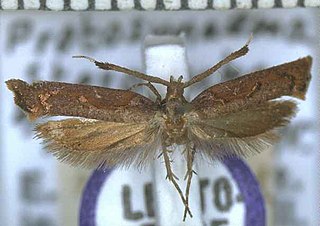
Asaphodes is a genus of moths in the family Geometridae erected by Edward Meyrick in 1885. This genus is endemic to New Zealand and species within this genus are found throughout New Zealand including the North, South and Stewart / Rakiura Islands.

Parienia is a genus of moths belonging to the subfamily Olethreutinae of the family Tortricidae. This genus was described by Edward Meyrick in 1881. It consists of only one species, Parienia mochlophorana, which is endemic to New Zealand.

Sabatinca chrysargyra is a species of moth belonging to the family Micropterigidae. It was described by Edward Meyrick in 1886 and is endemic to New Zealand. It can can be found from Franz Josef Glacier / Kā Roimata o Hine Hukatere south but only on the western side of the South Island. Adults are on the wing from the beginning of October until the middle of January. Larvae likely feed on foliose liverworts and have been found on species in the genus Plagiochila. The adult moths live in a range of habitats preferring sunny open spaces in forests or snow-tussock grasslands that can range in altitude from near sea level up to 1,230 m. This species is very similar in appearance to Sabatinca aemula and dissection of genitalia is required to distinguish between the two species.

Mnesarchella hamadelpha is a species of primitive moth in the family Mnesarchaeidae. It is endemic to New Zealand and is found in the Wellington, Marlborough Sounds, Marlborough and Nelson regions. It is frequently found at altitudes of between 800 and 1400m but can be found as low as approximately 400 m. It is often found in damp moss covered but well lit native forest. This species is very similar in appearance to M. acuta. However although M. hamadelpha is present in the same locations as M. acuta, it is usually found at higher altitudes or at later times in the year. Adults are on the wing from November to February.

Charixena iridoxa, also known as the Astelia zig-zag moth, is a moth of the family Plutellidae. It was first described by Edward Meyrick in 1916. This species is endemic to New Zealand and has been observed in the North, South and Stewart Islands. The life cycle of this moth is at least two years in length with the larvae inhabiting the bulb of its host plants and mining the underside of its leaves. These mines have a distinctive zig-zag appearance and can be easily recognised when looked for on the host plants. The larvae pupate in a cocoon attached to the leaf and this stage takes place between February and August. The adult moths emerge in the early spring and are fast, day flying moths. Their larval hosts are plants in the genus Astelia and include Astelia fragrans and Astelia nervosa.

Gymnobathra callixyla is a moth in the family Oecophoridae first described by Edward Meyrick in 1888. It is endemic to New Zealand.

Aristotelia paradesma is a moth of the family Gelechiidae. It was described by Edward Meyrick in 1885 and is endemic to New Zealand. This species has been observed on both the North and South Islands. The larvae feed on Coprosma species creating and living in stem galls. The adults are on the wing from November to March and are attracted to light.

Endophthora tylogramma is a species of moth in the family Tineidae. It was described by Edward Meyrick in 1924. This species is endemic to New Zealand.

Tingena is a genus of the concealer moth family (Oecophoridae). This genus is endemic to New Zealand.

Mallobathra is a genus of moths belonging to the family Psychidae, and are bagworm moths. This genus was first described by Edward Meyrick. It is endemic to New Zealand. The type species of this genus is Mallobathra crataea.

Tingena chloritis is a species of moth in the family Oecophoridae. It is endemic to New Zealand and has been found in the South Island. Larvae of this species feed on leaf litter. The adults of this species are light flyers and are attracted to light.

Tingena idiogama is a species of moth in the family Oecophoridae. It is endemic to New Zealand and has been observed on the slopes of Mount Taranaki. Its preferred habitat is native subalpine scrub and adults are on the wing in January.

Tingena nycteris is a species of moth in the family Oecophoridae. It is endemic to New Zealand and has been observed in the North and South Islands. This species inhabits native forest and scrubland and adults are on the wing from October to January.

Tortrix zestodes is a species of moth of the family Tortricidae. It is endemic to New Zealand. It is likely that this species probably belongs to another genus and as such this species is also known as Tortrix (s.l.) zestodes.

Atomotricha prospiciens is a moth in the family Oecophoridae first described by Edward Meyrick in 1924. It is endemic to New Zealand.

Orthenches chartularia is a moth of the family Plutellidae first described by Edward Meyrick in 1924. It is endemic to New Zealand and can be found in the North and South Islands. This species inhabits open grassy areas in native subalpine forest. Adults are on the wing in January and February.

Protosynaema eratopis is a species of moth in the family Plutellidae first described by Edward Meyrick in 1885. It is endemic to New Zealand.

Protosynaema hymenopis is a species of moth in the family Plutellidae first described by Edward Meyrick in 1935. It is endemic to New Zealand.

Protosynaema matutina is a species of moth in the family Plutellidae first described by Alfred Philpott in 1928. It is endemic to New Zealand.

Protosynaema steropucha is a species of moth in the family Plutellidae first described by Edward Meyrick in 1885. It is endemic to New Zealand.




















